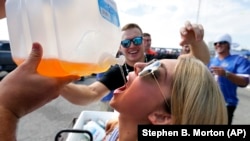Popular culture often shows alcohol as a big part of the college experience in the United States.
Television programs and movies about American college life have images of wild parties with young people either drinking alcohol or holding a drink.
Now, a new study of alcohol use suggests that some college students may be missing meals so they can have more drinks or get drunk faster. Researchers are calling this kind of behavior, "drunkorexia."
The study involved 1,184 college students between the ages of 18 and 26 years. Most of the students attended the University of Houston in Houston, Texas, while the others went to school in other parts of the country.
Researchers asked the students about their alcohol use. They found that 80 percent of those studied had demonstrated some kind of drunkorexia in the past three months. They had performed heavy physical exercise, eaten low calorie meals or even missed meals for up to a full day before drinking alcohol.
Dipali Rinker organized the study and presented its findings to the Research Society on Alcoholism in June. Rinker teaches psychology at the University of Houston. She says students see drunkorexia as way to keep their body weight down while drinking alcohol. And it causes them to feel the effects of alcohol quickly and with more intensity.
Rinker says unhealthy eating habits are only one of the reasons this type of behavior is dangerous. Heavy drinking is linked to drunk driving – operating a vehicle while drunk -- unprotected sex, sexual assault and alcohol poisoning.
The National Institute on Alcohol Abuse and Alcoholism is a U.S. governmental agency that studies alcohol related problems. It found that about 1,825 college students between 18 and 24 years old die from alcohol-related injuries every year.
Nicole Mattern attends the Catholic University of America in Washington, D.C. She says drinking is common among the students she knows at the school.
It is a violation of U.S. law for anyone under the age of 21 to buy alcoholic drinks. But Mattern says many students under 21 use false documents to enter drinking establishments and buy alcohol.
Mattern says she and her friends only drink alcohol in their free time after their schoolwork is done. But she believes that drinking is an undeniable part of life on a U.S. college campus.
"Young people have normalized the drinking culture. Some people have been drinking since they were 16 and they’re not just going to stop because they’re in a different environment."
The National Institute on Alcohol Abuse and Alcoholism looked at how often college students used alcohol in 2014. It found that almost 60 percent of college students between 18 and 22 years old had at least one drink in the month before being asked about their drinking habits.
Rinker at the University of Houston says one reason alcohol use is so common is because students believe everyone around them is drinking. They believe they are expected to drink and get drunk.
"There’s this sense of invincibility and the sense this is time in life in which it’s sort of okay … to push those boundaries a little bit. So when you combine the … perception of 'This is okay. This is what you do in college. This is what other college students are doing' … with this developmental time period … all of that creates a context for engaging in heavy and risky drinking behaviors."
George Koob directs the National Institute on Alcohol Abuse and Alcoholism. He says another reason young adults turn to alcohol is that they have a great deal of freedom. He says this mainly affects students in their first year of college.
"This may be different in other countries, but in the United States for sure, this is the first time they’ve left home, in many cases. It’s the first time they have an unstructured environment. It’s the first time they’re independent. And all these things lead to them needing to make choices."
First year students often drink with more intensity than others, Koob adds. However, both he and Rinker agree that students in sports programs, college fraternities and sororities drink more than other students.
Koob says that the percent of students using alcohol has not increased in recent years. But what worries him is that the number of students drinking to the point of "blacking out" has increased.
Blacking out is when a person drinks so much alcohol they have no memory of their actions while drunk.
Blacking out often results from "binge drinking." The National Institute on Alcohol Abuse and Alcoholism defines binge drinking differently for men and women because their bodies process alcohol differently. For a woman, binge drinking means having at least four alcoholic drinks in two hours. For a man it means having at least five drinks over the same period.
The institute reported that almost 38 percent of students between 18 and 22 years old "binge drank" in the month before being asked about their drinking habits in 2014.
Koob notes that college students in Canada and Europe also face issues with alcohol. But he feels a big part of the problem is that Americans do not fully understand alcohol’s effects. Most people do not know that the part of the brain where decisions are made is not fully developed until age 25.
Most people do not know that alcohol harms the development of that part of the brain, he adds.
Koob and Rinker agree that there are many different ways schools can try to deal with the issue of student drinking. There is no single best method.
The National Institute on Alcohol Abuse and Alcoholism released a report listing many different possibilities for school administrators last year.
The report, called CollegeAIM, said colleges can attempt to ban alcohol use completely. But this has yet to be shown as the most effective solution.
Koob and Rinker say schools must at least educate students about safe drinking. Also, schools should try to show students that their ideas about drinking are not completely true.
Rinker says young people need to know that many of their student peers do not drink large amounts of alcohol. Schools must also continue discussing the issue of alcohol with students throughout their period of study. Most schools only offer training to students during their first year, she says.
Ken Ballom is the dean of students at the University of Illinois at Urbana-Champaign. The college rating service Princeton Review listed the school as the number one party school out of 380 schools in 2015.
Ballom say he is not sure why his university is considered a party school. He feels it is better known for its academic programs. But he understands that all universities must do all they can to address the problems of alcohol use on their campuses.
The University of Illinois works with the local police to prevent alcohol-related incidents. The school also offers medical amnesty. This means the university does not punish students for violating rules governing alcohol if the students seek medical assistance.
But Ballom says the best solutions begin with communication. He feels that students, parents and administrators all must discuss how alcohol affects the college environment.
"Parents of current or incoming students play a role in being involved in addressing alcohol related matters with their sons and daughters."
Ballom says that students should understand that alcohol is not an important part of the college experience. And, he adds, there are many activities for college students that do not involve alcohol.
I’m Pete Musto.
Pete Musto reported on this story for VOA Learning English. George Grow was the editor.
We want to hear from you. How big of a part of the college experience is drinking alcohol in your country? How should schools address alcohol related issues? Write to us in the Comments Section. Write to us in the Comments Section or on our Facebook page.
________________________________________________________________
Words in This Story
calorie – n. a unit of heat used to indicate the amount of energy that foods will produce in the human body
habit(s) – n. something that a person does often in a regular and repeated way
drunk – n. having drank so much alcohol that normal actions such as talking, thinking, and moving become difficult to do
sexual assault – n. the crime of touching someone sexually without that person's permission
campus – n. the area and buildings around a university, college or school
normalize(d) – v. to make someone or something that is usually considered unusual or abnormal become considered as normal
invincibility – n. the state of being impossible to defeat or overcome
boundaries – n. unofficial rules about what should not be done
perception – n. the way you think about or understand someone or something
engaging in – p.v. doing something
fraternities – n. social organizations of male students at a U.S. college
sororities – n. social organizations of female students at a U.S. college
peer(s) – n. a person who belongs to the same age group or social group as someone else
dean – n. a person whose job is to give advice to the students in a college or high school and to make sure that they obey the school's rules
academic – adj. of or relating to schools and education
amnesty – n. a decision that a group of people will not be punished or that a group of prisoners will be allowed to go free







